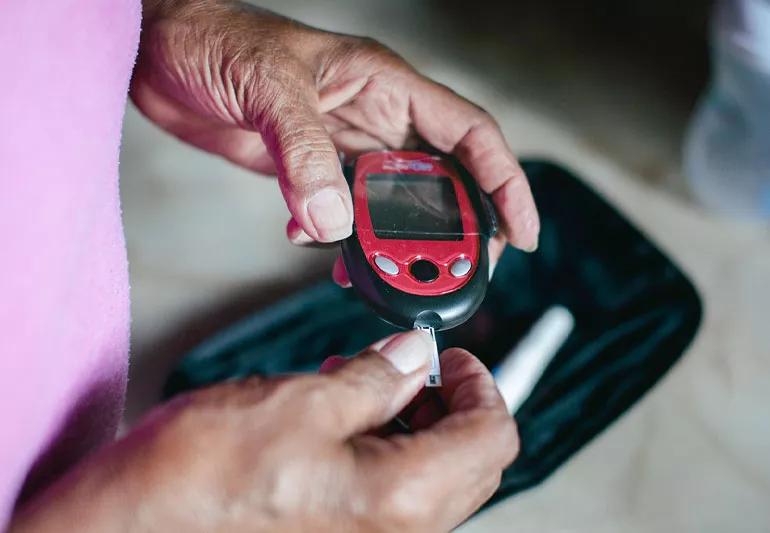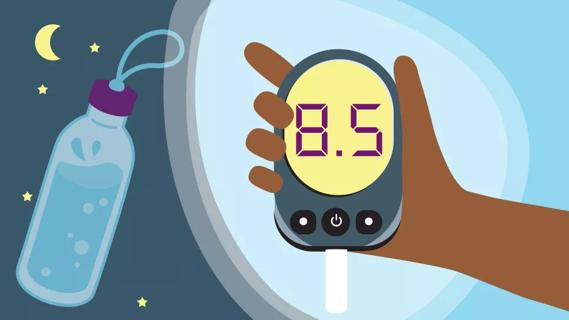Keeping blood glucose levels in a healthy range is critical with diabetes-related vision issues

If you have diabetes, your view of the world may change if you don’t manage your blood sugar (glucose) levels.
Advertisement
Cleveland Clinic is a non-profit academic medical center. Advertising on our site helps support our mission. We do not endorse non-Cleveland Clinic products or services. Policy
Consistently high glucose is the driving force behind diabetes-related macular edema (DME), a progressive eye disease. The early stages of DME can blur and distort your vision. Eventually, it may cause irreversible loss of central vision.
But in many ways, you can manage whether DME escalates as a complication of your diabetes. What can you do to limit damage? Let’s find out from ophthalmologist Ananth Sastry, MD, and diabetes care and education specialist Shannon Knapp, MEd, BSN, RN, CDCES.
Understanding what fuels DME begins with understanding the destructive power of diabetes and hyperglycemia, the medical term for when there’s too much sugar in your blood.
Damage occurs throughout your body if blood sugar levels remain elevated for long periods of time. (We’re talking months or years.) The harm includes the hardening and narrowing of blood vessels — which brings us to your eyes.
Microscopic blood vessels serve your retinas, the light-sensitive tissue lining the back of the eye. High blood sugar slowly but surely weakens those blood vessels. Eventually, that can lead to leaks.
“The retina is like a sponge,” explains Dr. Sastry. “As it soaks in fluid that leaks out from the blood vessel, it develops swelling [DME] that results in decreased or blurred vision.”
Advertisement
There’s a pretty direct cause-and-effect relationship behind the development and progression of DME. Given that, preventing DME or slowing down the condition often hinges on your ability to keep glucose levels within a healthy range.
“This is why blood sugar management is so important in diabetes care,” says Knapp. “It’s how we fend off potential problems.”
But there’s no ONE way to manage blood glucose. Many different factors can cause your blood sugar to skyrocket and linger at a higher-than-desired level. (A typical glucose target is 80 to 130 mg/dL, or milligrams per deciliter, before meals and no more than 180 mg/dL after eating.)
“It doesn’t matter how you keep your blood sugar within your target range,” notes Knapp. “It’s just important that you do it.”
Here are eight ways to meet that goal:
When it comes to DME, consider “heart-healthy” food to be eye-healthy food.
Building your daily menu with whole grains, vegetables, fruits and lean protein can help keep your arteries strong and blood glucose in check, says Knapp. A meal plan that fits within the Mediterranean diet lines up well with heart and diabetes dietary recommendations.
Want to make things really simple? Then try following the “Plate Method” recommended by the American Diabetes Association. The plan calls for dividing up your plate and filling it like this:
It’s best to avoid or limit heavily processed food that’s high in saturated fat. Try to minimize items that are high in sugar and salt, too, as neither will do you any favors when it comes to managing blood sugar and artery health.
Diabetes medications can help you manage your blood glucose and protect your vision.
Various medications that work in different ways can lower your blood sugar levels, says Knapp. Understanding exactly what your medication does and taking it as prescribed is key to keeping blood sugar well managed.
“Talk to your healthcare provider to stay informed,” she advises. “Ask questions and be involved so you know how to use your medication in the best way possible.”
Taking action to lower your blood sugar begins with learning that it’s high. That’s why it’s important to have an established monitoring regimen to make decisions about meals, medications and activities.
Advertisement
There are two main ways to monitor blood sugar: a glucose meter (following a finger prick) or a continuous glucose monitor (CGM). Make sure you’re using one.
Regular exercise can help you consistently see lower blood sugar levels that keep your eyes healthy. (Fast fact: An individual workout can affect blood glucose for 24 hours!)
A word of caution, though: Some activities may hit you differently. Checking your glucose before and after exercise can give you a better idea of how your body is responding.
Talk with your healthcare provider about what might be safe for you.
During stressful times, your body releases adrenaline as part of its “fight-or-flight” response. The rush of this hormone into your bloodstream causes numerous physiological changes — including a boost in blood sugar.
Calming techniques such as yoga and meditation can help you limit and manage stress to keep glucose levels stable.
Illness can also stress your body and make managing blood sugar more difficult. That’s why it’s recommended that anyone with diabetes get an annual flu shot (to guard against influenza) and other vaccines.
Need another reason to stop smoking or never pick up a cigarette? The nicotine in tobacco can elevate your blood sugar and make managing it much more difficult.
Advertisement
If you have diabetes, make sure your calendar includes regular visits to an ophthalmologist to monitor your DME, as well as to check for diabetes-related retinopathy or other issues. The earlier you begin to treat DME and make helpful lifestyle changes, the greater the opportunity to preserve your vision.
“If the disease is caught and managed early, it can be treated effectively or even reversed, which can maximize good vision throughout one’s lifetime,” states Dr. Sastry.
A person with diabetes doesn’t get days or even hours off from thinking about the condition and what it can do to your body — including your eyes.
Managing diabetes requires constant vigilance given how much daily life affects blood sugar levels. Addressing elevated glucose levels to minimize long-term issues like DME may mean adjusting meals, medications or other parts of your life.
“It comes down to problem-solving,” says Knapp. “If your blood sugar is high, you need a plan to address it.”
Advertisement
Learn more about our editorial process.
Advertisement

Getting connected to the right healthcare providers can make a big difference

Taking care of yourself helps you take care of your loved one

Installing grab bars and taping down area rugs may make navigating life with vision loss easier

Planning ahead, checking in with your care team and being vigilant about blood sugar monitoring can help ensure a safe fast

Even a short walk can make a positive difference

Watch your diet, exercise regularly and get a blood glucose level screening early

Regular testing can help detect diabetes early on

Here's what to know about this way to classify carb-containing foods

Type 2 diabetes isn’t inevitable with these dietary changes

Applying a hot or cold compress can help with pain